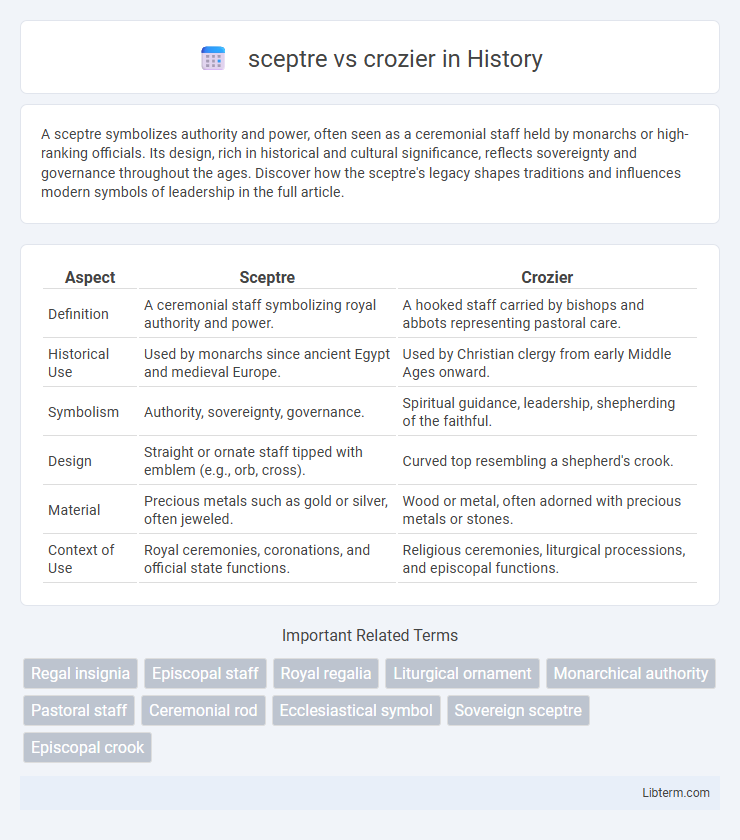A sceptre symbolizes authority and power, often seen as a ceremonial staff held by monarchs or high-ranking officials. Its design, rich in historical and cultural significance, reflects sovereignty and governance throughout the ages. Discover how the sceptre's legacy shapes traditions and influences modern symbols of leadership in the full article.
Table of Comparison
| Aspect | Sceptre | Crozier |
|---|---|---|
| Definition | A ceremonial staff symbolizing royal authority and power. | A hooked staff carried by bishops and abbots representing pastoral care. |
| Historical Use | Used by monarchs since ancient Egypt and medieval Europe. | Used by Christian clergy from early Middle Ages onward. |
| Symbolism | Authority, sovereignty, governance. | Spiritual guidance, leadership, shepherding of the faithful. |
| Design | Straight or ornate staff tipped with emblem (e.g., orb, cross). | Curved top resembling a shepherd's crook. |
| Material | Precious metals such as gold or silver, often jeweled. | Wood or metal, often adorned with precious metals or stones. |
| Context of Use | Royal ceremonies, coronations, and official state functions. | Religious ceremonies, liturgical processions, and episcopal functions. |
Introduction: Sceptre and Crozier Defined
A sceptre is a ceremonial staff symbolizing royal authority, often held by monarchs during official events or coronations. A crozier, in contrast, is a hooked staff carried by high-ranking church officials like bishops or abbots, representing spiritual leadership and pastoral care. Both objects serve as powerful emblems of governance, with the sceptre linked to secular power and the crozier to ecclesiastical authority.
Historical Origins of the Sceptre
The historical origins of the sceptre trace back to ancient Egypt and Mesopotamia, where it symbolized divine authority and royal power. Used by pharaohs and kings, it evolved as a ceremonial staff embodying sovereignty and governance throughout various cultures. The sceptre's design and significance influenced later European monarchical traditions, contrasting with the crozier's ecclesiastical associations.
Historical Origins of the Crozier
The crozier originated in the early Christian Church as a symbol of the bishop's pastoral authority, resembling a shepherd's crook to signify guidance and care for the faithful. Its roots can be traced back to the Roman pastoral staff used by shepherds, adapted in the 4th century to represent episcopal power and spiritual leadership. Unlike the sceptre, which symbolizes royal authority and governance, the crozier emphasizes ecclesiastical authority and the bishop's role as a spiritual shepherd.
Symbolic Meaning of the Sceptre
The sceptre symbolizes sovereign authority and divine right, often held by monarchs as a tangible representation of their power and governance. Unlike the crozier, which signifies pastoral care and spiritual leadership within the church, the sceptre embodies worldly rule and legal authority. Its ornate design frequently incorporates symbols of justice and strength, reinforcing the ruler's legitimacy and command.
Symbolic Meaning of the Crozier
The crozier symbolizes the pastoral authority and spiritual leadership of bishops and abbots, representing their role as shepherds guiding their flock. Often shaped like a shepherd's staff, the crozier embodies care, protection, and the duty to govern with wisdom and compassion. This sacred emblem contrasts with the sceptre, which typically signifies royal power and secular authority.
Uses in Secular and Religious Ceremonies
Sceptres serve as symbols of royal authority and governance in secular ceremonies such as coronations and state inaugurations, representing power and sovereignty. Croziers, shaped like a shepherd's staff, are emblematic of pastoral care and spiritual authority in religious ceremonies, especially within Christian traditions during ordinations and church processions. Both objects signify leadership but differ in context, with the sceptre rooted in monarchy and the crozier in ecclesiastical offices.
Design and Iconography Comparison
The sceptre typically features a straight, ornamental rod topped with a symbolic figure such as a fleur-de-lis or an orb, representing royal authority and sovereignty, while the crozier is a staff with a distinctive curved or hooked top resembling a shepherd's crook, symbolizing pastoral care and ecclesiastical leadership. Design elements of the sceptre often include intricate metalwork, gemstones, and heraldic motifs reflecting temporal power, contrasting with the crozier's simpler, more organic lines and religious iconography like crosses or serpent motifs that emphasize spiritual guidance. Both objects serve as powerful visual symbols within their respective contexts, with the sceptre embodying monarchical power and the crozier signifying episcopal office in Christian art and regalia.
Influence in Modern Traditions
The sceptre and crozier remain prominent symbols of authority and spiritual leadership in modern traditions, with the sceptre often representing royal power and governance, while the crozier symbolizes pastoral care and ecclesiastical authority. In contemporary ceremonies, monarchs wield sceptres to signify sovereign legitimacy, whereas bishops carry croziers as an emblem of their role as shepherds to their congregations. These artifacts continue to influence modern rituals, reinforcing hierarchical structures and cultural heritage within both secular and religious institutions.
Sceptre and Crozier in Art and Literature
Sceptres and croziers symbolize authority and spiritual leadership, frequently depicted in art and literature to convey power and divine right. The sceptre, often adorned with intricate designs and precious metals, represents royal sovereignty and worldly authority in numerous paintings and literary works. In contrast, the crozier, resembling a shepherd's staff, is symbolically linked to ecclesiastical authority and pastoral care, emphasizing the clerical role in guiding and protecting the faithful.
Conclusion: Legacy and Contemporary Relevance
The sceptre and crozier symbolize distinct forms of authority, with the sceptre representing royal power and the crozier embodying ecclesiastical leadership. Their legacy endures in modern ceremonial practices, reflecting the historical continuity of governance and spiritual guidance. Contemporary relevance lies in their use as powerful visual symbols during state and church rituals, reinforcing institutional identity and tradition.
sceptre Infographic

 libterm.com
libterm.com